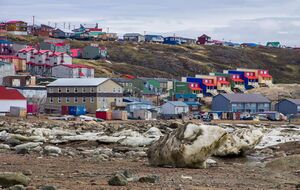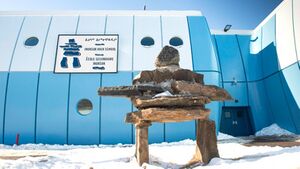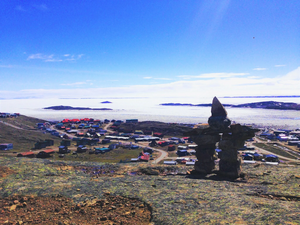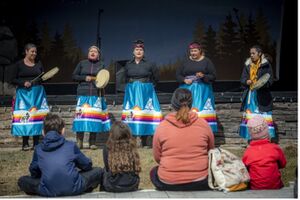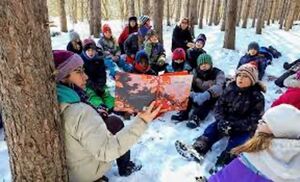Group 10
The Nakasuk School (ᐃᓕᓐᓂᐊᕐᕕᒃ)
Style and Affect: Iqualuit 2040
To someone reading this in the present, the hope is that our approach to education and the ideas listed would feel revolutionary and would hopefully beg the question: “why aren’t these already implemented into schools?”. Especially seeing as we live in a highly digital age, the ideas revolving around holistic and outdoor education would be highly beneficial to students who spend countless hours on social media, watching TV, etc. Our hope is to give readers the impression that this type of schooling goes beyond the academics, and reaches the souls of students to help them connect with nature and lift their spirits through being grounded through nature.
While schools currently do not place much attention on the health and well-being of students, and often, to students, they feel like many classes they are forced to take in high school are not particularly useful or applicable to them. Therefore, our life-skills workshops would hopefully bring a sense of renewed excitement for education to students and parents. This would hopefully provide motivation for high school students to go to school, it would greatly impact their mental health, hopefully reduce the use of drugs and alcohol and would help students find a new love for learning, for the outdoors and help them find their path in life.
To convey our ideas through our wording and in order to effectively communicate our ideas to the full effect of their potential benefits, we will be sure to emphasize the growth that would come of it. We would be sure to communicate the benefits of this approach on students’ health and physical & mental wellness, and their growth as, not only students but as productive members of society, learning skills that would equip them for the rest of their lives. The wording we would use would be similar to the previous paragraph- highlighting the benefits and the positive impact it will have on students.
As readers read the ideas we have come up with, we hope they will bring a sense of excitement and hope for the future of education. Ideally, this futuristic world would get a renewed sense of enthusiasm for education for all parties involved; students, parents and educators. Parents could see the benefits of this approach and see how it would greatly impact their children, and in turn, it would greatly impact their families. We hope that these ideas can bring hope to families, enthusiasm for high school students, and even a renewed passion for teachers as they take on this new approach to education that would bring more meaning to their careers, more joy to their day and have positive effects on their wellbeing too. Readers are hopefully encouraged to enter the education field, or students are encouraged and looking forward to their education after hearing this, knowing that this could be implemented in their school, and parents can be hopeful of their kids’ futures.
Geographical Information
Iqaluit is the capital of Nunavut, Canada's northernmost province. Located just outside the Arctic Circle, it is surrounded by tundra, mountains, and rivers. The city lies at the northern part of Baffin Island and was formerly named Frobisher Bay after the nearby Bay (Iqaluit, 2024). Since its reformation from a trading post to a city in 2001 Iqaluit has become the target community in Nunavut (Iqaluit, 2024). Despite being an Artic town the city of Iqaluit has a full range of services from hospitals, banks, schools, and daycares to museums, art galleries, and places of worship. The city also acts as a hub of communication for Nunavut and has access to a satellite communications network.
Iqaluit’s economy is largely based on government work with few private sector opportunities. Most of the economy is based on mineral extraction - however, due to the high production costs due to the near arctic location wealth generation from these resources is slow. Overall, the federal government acts as the primary employer in Iqaluit and Nunavut, providing jobs in electricity, administration, healthcare, education, welfare and mining infrastructure (Newberry, 2023). Fishing is another main source of economic growth with small communities in Nunavut exporting local fish to southern Canada (Newberry, 2023). However, in the year 2040, the private sector has expanded slowly and now accounts for about 30% of jobs (Newberry, 2023). Private sector work includes construction, retail, tourism, as well as the arts (Newberry, 2023). The key issue facing Iqaluit is the cost of living. In the early 2020s, it was noted that while wages were high in Iqaluit the cost of living was equally so. Persons who lived in Iqaluit were faced with high costs of resources and housing as the environment made it hard for most resources to be made locally. For example, most groceries are imported causing the price to increase.
Iqaluit’s unique geographical position relative to other provinces makes it uniquely positioned to encompass a plethora of activities - for a northern city. The most pressing issue facing Iqaluit is how to balance Inuit tradition and the changes coming with citizens moving from the south. Despite being a northern city, Iqaluit is home to diverse ethnic demographics with 52% Inuit, 12% Scottish, 11% Irish, and a further 12% being visible minorities including Black, Filipino, and South Asian people (Iqaluit, 2024). In 2040 this diversity creates minor tensions as Inuit ways of life clash continue to clash with southern Canadian modes of life and governance. Additionally, Iqaluit also is home to a French-speaking population. This is due to its close proximity to Quebec which lies to the southeast across the Hudson Strait. The French community boasts its own school and community centre for Francophones.
Due to the arctic environment, Iqaluit is home to a large variety of winter activities. In the 2020s dog sledding, cross-country skiing, and snowmobiling are among the most popular activities in Iqaluit (Iqaluit, 2024). During the summer months boating, river rafting, canoeing, and kayaking are similarly popular. Iqaluit is also home to hiking trails, fishing spots, campsites and berry picking in the nearby Sylvia Grinnell Park (Iqaluit, 2024). In 2040 with climate change progressing since the early 2020s summer activities have become more popular with visitors and citizens enjoying these activities for extended periods of the year. Hunting is also a popular activity in Iqaluit, however, by 2040 climate change had affected the native wildlife and caused populations to dwindle making hunting a rarely permitted activity.
Cultural Background
Iqaluit people view culture as dynamic and evolving, deeply tied to the land and its cycles. Traditional knowledge is not seen as a relic but as a foundation for daily life where language, community gatherings, respect for the land/living things, and hands-on learning pedology thrive. The Nakasuk School (ᐃᓕᓐᓂᐊᕐᕕᒃ) embraces the Inuit principle of Piliriqatigiinniq, meaning working together for a common purpose to help guide the interconnectedness between the community culture and the Nakasuk School (Healy, 2014).
For the people of Iqaluit, language is the essence of cultural identity. At the Nakasuk School, Indigenous languages are taught alongside English to foster a deep respect for cultural inclusivity. Storytelling is a particularly cherished tradition, where elders are invited as guest speakers to recount ancestral tales and lessons. These stories teach children about resilience, respect for the land, and the importance of interconnectedness. By preserving and celebrating Indigenous languages alongside others, the Nakasuk School ensures that students remain rooted in their identity even as they prepare to engage with the rest of Ontario as they graduate and go on to university elsewhere.
The culture of Iqaluit is one of joyful gatherings and shared celebrations. The Nakasuk School serves as a hub for community events, from feasts to storytelling festivals held under the midnight sun. Families gather in the Nakasuk School central hall for drum dances, sharing songs and traditions that have been passed down for generations. See the image below of one of our midnight sun ceremonies [figure 1].These events are opportunities to strengthen bonds, pass on teachings, and celebrate the accomplishments of students who embody both modern knowledge and traditional values. Hence, these community events foster a notion of belonging and interconnectedness among the remote teacher who typically fly in and are distanced from their families.
The native people of Iqaluit live in harmony with the Arctic environment, embracing a profound respect for the land, the climate and the living organisms that share it. The Nakasuk School mirrors this deep connection, integrating environmental stewardship and cultural practices into its core curriculum. Outdoor classrooms and seasonal camps have become integral to education, immersing students in the Arctic's vibrant ecosystem. See the image below of one of our outdoor classrooms[figure2]. Lessons focus on the balance required to sustain life in such a harsh environment, emphasizing the importance of giving back to the land. This relationship with the natural world is not just an academic lesson but a deeply ingrained way of life for the Iqaluit people, ensuring that future generations continue to uphold the respect and responsibility that define Inuit culture. This culture of environmental sustainability, centred on coexistence with all living organisms, helps develop the guiding principles of the Nakasuk School.
Hands-on learning is also a core principle of both Inuit culture and the pedagogical approach at the Nakasuk School. This is rooted in the Inuit tradition of learning through observation, imitation, and practice; this method ensures that knowledge is a lived experience as Brayboy (2009) envisioned. In Iqaluit, cultural teachings such as crafting tools, navigating the Arctic landscape, monitoring sea ice are taught by doing. Thus, connecting theoretical concepts to real-world applications. This hands-on pedagogy mirrors the interconnectedness central to Inuit culture, emphasizing relationships between people, their environment, and living organisms. Thus, the Nakasuk School embraces these cultural aspects and offers them as electives that students can pursue as a part of the Nakasuk School initiative of a holistic education experience. x
Setting the Scene
As of 2024, Iqualuit’s Nakasuk School (ᐃᓕᓐᓂᐊᕐᕕᒃ), located in the heart of the city, forms the basis of education for nearly all the children and youth. The elementary school contains several unique features: it is insulated from the cold through specific utilisation of building materials, it contains a single door and no windows, two floors with the second having a grand focus on technology, and its few classrooms are considered to be open classes. Regardless of weather, it begins at 8:45am and finishes at 3:45pm. The Nanasuk school calendar only includes one Indigenous Holiday.
According to Maclean’s, Nunavut may offer two special aspects for teachers: beautiful landscapes, and very attractive compensation packages (Government of Nunavut, 2022). The constant demand for teachers has not decreased in the slightest over recent years. Deputy minister of education for the Government of Nunavut, Rebecca Hainu, states “The need for teachers in Nunavut is never ending because we’re such a vast land with a scattered population” (Government of Nunavut, 2022). There are an approximate number of 11,000 students and an estimated amount of 870 teaching positions to fill (ibid).
Unfortunately, demand outweighs qualification and in some cases, non-qualified candidates are hired. According to Hainu, “Kids raised in isolated communities benefit from teachers who come from different parts of the world and spark their interest. It helps them become global citizens.” (Government of Nunavut, 2022). Teacher candidates from other provinces are encouraged, given the tight-knit, isolated community of Iqaluit. With this, teachers earn a competitive salary and benefits in Nunavut, and in some cases, a Northern living allowance. The disparity in demand of teachers is seen especially when noted that the government provides teachers professional leave to further their education. Moreover, the Iqaluit community is very welcoming and may offer unique professional opportunities to teachers.
Although the schools may have dedicated administration and teachers, the students feel as though an education gap exists between Nunavut and the rest of Canada. Upon asking Nunavut students how they feel about their learning at schools in Iqaluit, a prevailing number of students described that they feel less educated and less prepared than students in other provinces. The unfairness that students felt was evidently conveyed by Grade 11 student Lily Parr, who said “there are actually students like me who want to learn more” (Zerehi, 2016). Parr realized just how behind the Iqaluit curriculum was when she moved to Paris, Ontario and attended a secondary school. Apart from offering a smaller variety of courses, schools in Nunavut struggle to provide adequate extracurricular activities as well. Former Rankin Inlet, a high school just outside of Iqaluit, student Christine Tootoo emphasized how schools in Iqaluit would benefit from having Inuit teachers teach in Nunavut. These teachers would be, as she outlined, “ rooted in the territory — instead of relying on teachers from the south who come and go every few years” (Zerehi, 2016). Additionally, Tootoo suggests integrating Inuit culture as part of the province’s curriculum to boost the youth’s confidence.
As of 2024, a dichotomy brews between perspectives of teachers, students, and the government on how to proceed with education in Nunavut.
Iqaluit 2040
The Iqaluit Nakasuk School (ᐃᓕᓐᓂᐊᕐᕕᒃ), located in the heart of the Arctic tundra, has become a leader in combining traditional practices with modern education. Over the past thirty years, the school has introduced innovative methods that have changed how students learn and connect with the world. These new approaches, rooted in a holistic education philosophy, highlight outdoor learning, mental wellness, and essential life skills, preparing students for success both inside and outside the classroom.
The outdoor learning program is one of the school’s most impactful changes. Education is no longer limited to classrooms; instead, students explore the Arctic landscape, bringing subjects like math, science, and geography to life. For example, they measure snowpack to understand climate change, create elevation maps to study geography, and observe wildlife to learn about ecosystems. Teachers have found that these hands-on experiences not only improve academic understanding but also build resilience, teamwork, and respect for the environment. Yoga sessions under the vast Arctic sky have become part of the daily routine, offering students a chance to improve focus while supporting their mental and physical well-being.
Another significant step forward has been the introduction of life skills workshops for students in grades 9 to 12. These workshops target important developmental needs. For grade 9 students, lessons focus on organization and study techniques, giving them the tools to manage their workload effectively. In grade 12, the workshops shift to stress management and self-care, helping students navigate the challenges of preparing for post-secondary education. Guest speakers, including nutritionists and mental health experts, offer real-world insights that make these sessions practical and relevant. Teachers have seen firsthand how these workshops not only improve academic performance but also foster emotional resilience.
The guest speaker program has also expanded in exciting ways. Alongside local elders and community leaders, professionals from across Canada and beyond are invited to share their expertise, creating meaningful connections between local traditions and global knowledge. Nutritionists speak about the impact of diet on brain function, while climate scientists discuss sustainable practices specific to the Arctic environment. These sessions inspire students to think beyond their immediate surroundings while staying deeply connected to their roots.
These innovations have transformed the Nakasuk School (ᐃᓕᓐᓂᐊᕐᕕᒃ), into a model for education in the North. By blending outdoor learning, mindfulness, and life skills, the school ensures students are prepared for a rapidly evolving world. The integration of environmental stewardship, hands-on exploration, and holistic wellness practices helps students develop as curious, grounded, and confident individuals. It’s a place where tradition and modernity coexist, where the land shapes every lesson, and where each new discovery benefits both students and teachers alike. The future of learning is being written here, in harmony with the Arctic’s vast and inspiring landscape.
